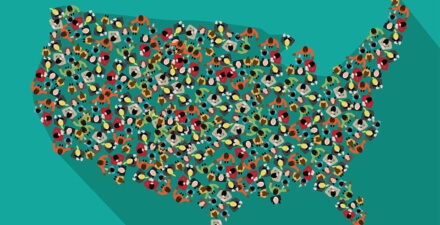Racial equity in U.S. data collection improves the accuracy of research, policy evaluation, and subsequent policymaking

The U.S. economy and society are rife with racial and ethnic inequalities, from wealth and income divides to disparities in health and well-being, education, and employment outcomes. These racial and ethnic inequalities are a result of centuries of systemic racism and discrimination, which prevents people of color from moving to better-paying work, accumulating wealth, and otherwise developing and fully deploying their human capital in the U.S. economy and labor market.
These disparities have only gotten wider during the coronavirus recession in 2020 and amid the continuing coronavirus pandemic. Economists and social science researchers have long debated and studied these trends, yet data collection and reporting have long faced obstacles in best reflecting the diversity of the U.S. economy. These challenges not only limit the scope of data-driven research but also obscure its findings and, in turn, impede efficient and effective policymaking aimed at promoting strong, stable, and broadly shared economic growth.
This was the general theme of an Equitable Growth and Groundwork Collaborative virtual event this past summer, “Data Infrastructure for the 21st Century: A Focus on Racial Equity,” in which I spoke on a panel of fellow academic experts on the importance of racial equity in federal data collection. My co-panelists and I—all scholars of color who study underrepresented populations and subpopulations in the United States—discussed actionable proposals to increase the quality and utility of data gathering and analysis.
One such technique is oversampling, a method in which particular groups are surveyed at higher rates than they actually appear in the population. Oversampling can facilitate data disaggregation for these underrepresented groups in the United States and enhance the accuracy and generalizability of research findings.
Aggregate data points and statistics, such as Gross Domestic Product or the unemployment rate, are inadequate representations of the current U.S. economic situation because they lump all populations together and calculate an average. In reality, various groups and subgroups of the U.S. population fare differently in the economy and across society, rendering averages inaccurate portrayals of most people’s lived experiences.
To properly measure how all U.S. workers and their families are faring in the labor market, or how policies are impacting their lives, disaggregating data is therefore essential.
As I mentioned in my opening remarks at the recent data infrastructure event, I do a lot of research on small groups in the U.S. population, such as American Indians, Alaska Natives, Native Hawaiians, and Pacific Islanders. This work is facilitated with the use of administrative data that contain the entire populations of AIAN or NHPI groups and thus make it possible to conduct statistical analysis and data disaggregation.
But it’s not only studies of these smaller demographic groups that benefit from better data disaggregation. Larger demographic groups such as Hispanic Americans and Asian Americans that tend to be clumped together in surveys have an array of subgroups that face diverse challenges and experience the U.S. workforce and economy differently.
When researchers use broad categories to analyze outcomes for these groups, we essentially just get the average effect and lose a lot of nuance that is incredibly valuable for our research and findings, as well as policy implications. (See the video for more details.)
There’s another side of this question of missing the nuance in research findings that comes from a lack of diversity among researchers doing the research, framing the questions, and surveying the population. It’s no secret that economics as a profession and a field in general has a diversity problem. Women, people of color, and especially women of color, face incredibly high barriers to entry and success, starting at the undergraduate and graduate level. For instance, in the United States, between 2015 and 2019, no economics doctorates were awarded to Native American women out of the 1,200 doctorates awarded in that time period.
This diversity problem extends beyond who studies economics or teaches it to the next generation. One of the many pitfalls of not having diversity among researchers is that certain areas of research, outcomes, and evaluation tend to be forgotten—many of which could inform future research and policy decisions.
One example I discussed at the virtual event this past summer is the universal basic income program that many American Indian tribes have provided for the past 25 years. This means there are extensive data that can shed light on the effects of a universal basic income on labor force participation or poverty rates, among other areas—yet no one is really talking about them or paying attention to them, despite the knowledge that policymakers could gain from learning about these communities’ long-run experience and the effect on their communities.
This is just one example. But there are probably many others that academics and policymakers alike don’t realize they are missing because of a lack of diversity among economists. These areas of unexplored research opportunities are often only known to the communities in which they are being put into practice, which means that without researchers from those communities, they will probably remain unknown.
This profound lack of diversity in economics not only limits the scope of academic research and policy evaluation but also curbs the effectiveness and creativity of policymaking itself, as well as the ability of federal, state, and local governments to set up effective economic and social programs that create better economic opportunities and build better communities.
Policymakers today have a unique opportunity to pass life-changing and essential legislation that will enable millions of Americans to achieve better economic and social outcomes in unprecedented fashion. But in order to fully comprehend the impact of these programs, we need disaggregated data to shed light on how various U.S. communities are affected by them, and we need economists from all backgrounds to analyze and evaluate those data. Not only will future research benefit from it, but so will the communities studied by academics and served by policymakers.
—Randy Akee is an associate professor in the Department of Public Policy and American Indian Studies at the University of California, Los Angeles.







